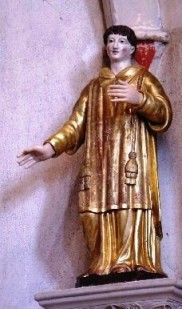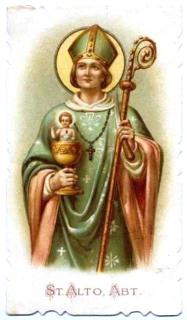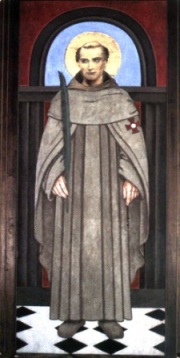Saint Baldomer for the locksmith.

Question: Hello, good evening. I write from Argentina. CONGRATULATIONS! for such a beautiful blog! Today I discovered and filled my day really. My son opened his business (...) locksmith. Some time ago I’m looking for who is the patron saint of locksmiths. I found a place that is Saint Peter, say for carrying keys. But I do not find it anywhere, nor prayers, nor the Ninth to Saint Peter, if this were really the patron saint. I can not find the Ninth to Jesus of Good Hope. If you know these prayers and these novenas, would you kindly send them? Thanks. A warm greeting from my beautiful Argentina.
Answer: Hello! Thank you for your kind words and praise for the blog, just do what I can heartily. I have to apologize for the delay, but the question had gone to spam, do not know why, and just out of view. And I answer, hoping that the business is going well. As you say, though St. Peter and other saints (1), are also employers locksmiths for keys, the traditional patron of the craftsmen of the keys is:
Saint Baldomer of Lyon, monk and subdeacon. February 27 and December 8 (translation of Savigny).
He lived in the seventh century, in the French city of Lyon, where he was a blacksmith and locksmith. Since young man had taken a vow of chastity, never married and considered the poor and homeless as their own children, even to sell their own tools more than once, to help the poorest. He was much loved and respected for his charity and pious life. On one occasion, while praying in the church of the monastery of Saint Just, saw the abbot Saint Vivencio (July 12), and was charmed and impressed by his modesty, he saw a glow out of it. Spoke to him and noting his holiness and spiritual life level, proposed to enter the monastery as a monk. It went, entered the monastery where he was professed and ordained subdeacon. He lived a pious life in the monastery, exercising the same office that had played out, until February 24, 630 or 650, date of death (due to poor quality of the documents, does not specify the year).
Although this is only what is known of him, the devotion has been steady, thanks to the many miracles that occurred in his grave. The "Acta Sanctorum" gets that from the seventh century, his name is inscribed on the martyrologies and his relics were venerated without interruption until the sixteenth century, when Protestants profane and disappeared, except for an arm that had previously been transferred to church dedicated to him in the Loire, and other relics that had previously been formally transferred to the monastery of Savigny.
According to the Big Book of Saints, Jacques Baudoin, also known as Gaumier Galmier. Lyon is the pattern of locksmiths and blacksmiths. His attributes are typical monastic robes, anvil, hammer, pliers and some keys.
As for the prayers you ask, here you can find some: www.devocionario.com. The subject of sentences, with few exceptions, do not deal here, since there is a devotional blog or pious.
(1)
San Benno of Meisen: To prevent the excommunicated emperor enter his cathedral, threw the keys to Elba. Some time later, a fish is the back. June 16.
Santa Lioba of St-Petersberg: was sacristan of his monastery and lost the keys to the choir, so the nuns could not go to pray. Before dawn, a fox came up to her and brought them. To tell Tetta, abbess, had been the demon thief. 23 and 28 (translation of relics) in September.
St. Erwin of Worcester: On certain sins of youth, put shackles for penance and threw the keys into a river. Going to Rome, a fish was caught in the Tiber and was in the keys. January 11.
St. Servatius of Tongeren: his iconography has always key because, according to legend, St. Peter himself appeared and gave him a silver key, a symbol of authority, but in reality is one of the "clavis confesionis" keys. Popes used to give as a prize to bishops or kings, which had alleged filings chains of St. Peter. 13 May.
San Maurilio of Angers: threw the keys to the cathedral to the river when he fled the city and, having caught a fish, he found inside, so he returned to his diocese. 13 September.
San Lolan: was church warden of St. Peter in Rome and one night he went to Scotland to preach. Mysteriously, the doors of St. Peter was not opened to the canons, they heard a voice say: "only he who closed the door, you can open." Sent a deacon and a subdeacon who reached Lolan. This, to know what happened, he cut his right hand, setting up the key and opened the basilica. 22 September.
St. Hubert: St. Peter himself appeared to the saint in his first Mass and gave him a golden key. It’s really another "clavis confesionis", in this case lost. 3 November.
By Ramon Rabre (text) and Marco Antonio Martinez Ruvalcaba (translation)

